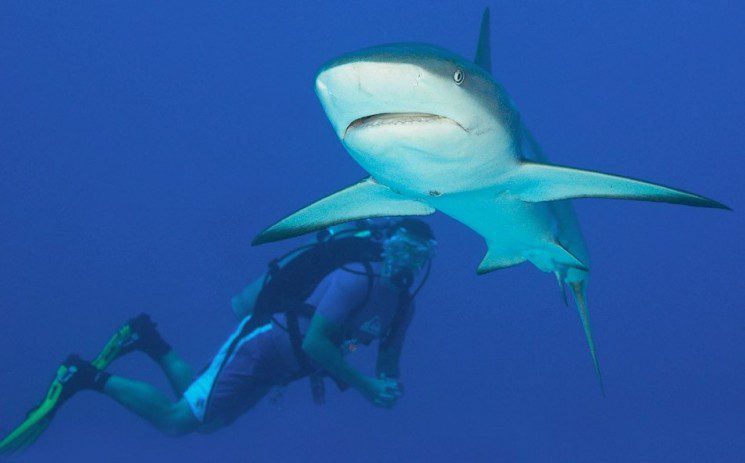By Alasdair Harris, BV’s Founder & Research Director, Madagascar
The vast reef systems that lie off western Madagascar are some of the least known coral reefs in the western part of the Indian Ocean. Shimmering mountains of calcium carbonate trace the island’s west coast, from coastal fringes nearshore to barriers and seamounts emerging from the sea floor over one hundred kilometres offshore. Flying over the Mozambique Channel along this part of Madagascar’s west coast, it’s hard not to be spellbound by the bewildering networks of seamounts and great walls of coral that suddenly rise up from the deep blue.

Black Tip Reef Shark (Carcharhinus melanopterus)
Madagascar possesses a colossal 2,250 square kilometres of shallow coral reef in total, and the vast majority of this lies offshore on the remote west coast. Because of its inaccessibility, and the rough conditions in the Mozambique Channel, very little of this reef system has ever been visited by divers, let alone studied scientifically.
We don’t yet know what the status of these reefs is, but reconnaissance work that we’ve carried out in the Barren Isles since 2009 suggests that these reefs are amongst the healthiest in the country. Aerial surveys carried out by researchers last year also showed this region to have an incredible abundance of large marine megafauna – from whales and dolphins to sharks and turtles, there’s more big stuff out here than anywhere else we’ve studied along this coast over the past decade.
It’s an incredible privilege to be diving into the unknown out here, and to be amongst the first scientists to look at these reefs. But beyond the science and the surveys, our work here is of urgent conservation importance, since this area has been highlighted as a priority for the development of the largest Marine Protected Area (MPA) in the country, which will be developed and zoned in partnership with traditional fishing communities as a Locally Managed Marine Area (LMMA).
Zoning will focus on maximising benefits to both biodiversity and traditional fisheries, and recommendations will draw on the findings of this expedition, so it’s essential that we cover as much ground as possible during this voyage. The Barren Isles LMMA is a bold and exciting vision, but once created, its sheer size will present a major challenge to conservation. The islands cover over 1,000 square kilometres of ocean, on a scale that is impossible for authorities to monitor or control.
It can take several days to sail the full length of the chain of islands; as we’re discovering on this trip. What’s more, Illegal, Unreported and Unregulated (IUU) fishing present a serious threat to the reefs of this region, and addressing this challenge is going to be key to making this LMMA work for biodiversity as well as for the region’s traditional fishing communities.
Since the political crisis that rocked Madagascar 3 years ago, accounts of IUU fishing have skyrocketed, with reports of fleets of highly destructive shark fishing boats and sea cucumber divers travelling to the islands from cities further north. As well as the threats to fragile marine life, these opportunistic fishers – many of whom operate from larger ships based offshore – threaten the sustainability of traditional fisheries in the region.
Madagascar’s fisheries surveillance service has a fleet of just three offshore vessels, one inshore boat and eight small zodiac speedboats. This service, charged with the surveillance of over five thousand kilometres of coastline – and the largest Exclusive Economic Zone (EEZ) of any Southern African Development Community (SADC) country – has had commendable success in fisheries enforcement, but it remains desperately under-resourced to meet the scale of the job in hand.
Given these challenges, ensuring the participation of the region’s fishing communities in efforts to improve monitoring, control of surveillance of fisheries is going to form a key part of our work supporting the Barren Isles LMMA. Our team in the town of Maintirano is cooperating with government agencies to help create the link between communities and fisheries surveillance authorities to help improve reporting of illegal fishing activity, and ultimately to bring an end to IUU fishing in this unique region.
For the next ten days on board the Nofy Be we’ll have our heads in the water as we focus our work on documenting the diversity of this stunning region. But the very real challenges facing this region serve to remind us that conservation here is about much more than biodiversity science alone.
Ultimately creating a sustainable future for the ecosystems and fishing communities of the Barren Isles is going to depend as much on people as it is on ecological data – the science we’re doing today is just the very beginning of a long journey of partnership building, advocacy, education, awareness raising and community support, that will inevitably take many years. If there’s one thing we’ve learned so far on this trip, it’s that marine conservation is about much more than just counting corals!


